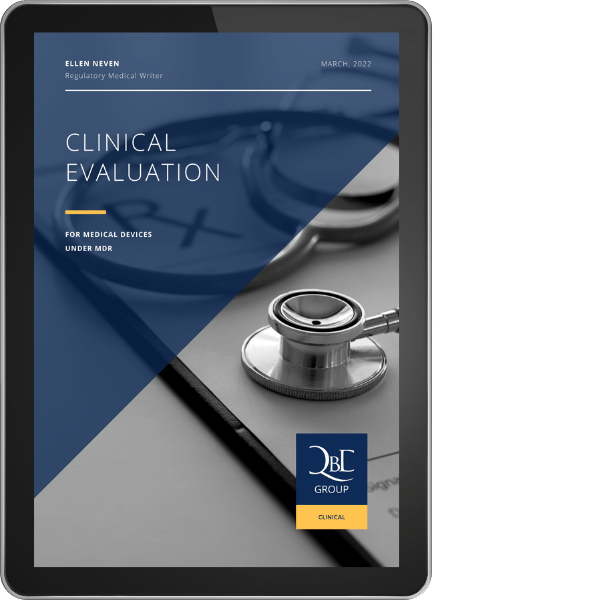Clinical evaluation of a medical device – defined as an ongoing collection, generation, appraisal, and analysis of clinical data related to your device – is central to obtaining and maintaining EU market approval.
The regulatory documents required to support credible clinical evidence for the safety and performance of your device are essential for device development and approval and should comply with strict regulatory guidelines (MDR 2017/745 and MEDDEV 2.7/1 version 4).
Let’s touch upon the fundamentals pertaining to the clinical evaluation process of your device.
Clinical evaluation for medical devices under MDR
What is clinical evaluation? – Meaning and purpose
To obtain a CE mark for a medical device, manufacturers are obliged to perform a clinical evaluation verifying the performance, safety and clinical benefits of their device when used according to the Instructions For Use (IFU).
Clinical evaluation of a medical device aims to show that the device offers more benefit and/or poses less risk than state-of-the-art treatments or is at least comparable to state-of-the-art technologies.
Clinical evidence may come from literature, clinical investigations and post-market surveillance (PMS). Both favourable and unfavourable data are to be considered in the clinical evaluation of the device.
The implementation of the MDR entails essential changes in the clinical evaluation process, its documentation, and PMS requirements.
In comparison with the Medical Device Directive (MDD), the clinical evaluation as such and the integration of PMS and risk management gain in importance under MDR, with more stringent requirements and subject to increased scrutiny by the Notified Bodies.
FREE WHITEPAPER
Clinical evaluation for medical devices under MDR
In this whitepaper, we’ll guide you through crucial regulatory documents pertaining to the clinical evaluation process of your medical device.
Clinical Evaluation – When?
Clinical evaluation starts during the development phase and is an ongoing process throughout the life cycle of a medical device.
In the pre-market phase, clinical evaluation identifies clinical safety and performance data that need to be generated before the device is marketed. At this early stage, gap analysis establishes which data still need to be generated with your device and whether clinical investigations are required.
An early start to the clinical evaluation process is of paramount importance because it pinpoints the questions to be answered by a clinical investigation and feeds the clinical strategy to be followed to get the required clinical data for CE marking.
For initial CE marking, clinical evaluation provides clinical evidence needed to demonstrate conformity with relevant safety and performance requirements when your device is used as intended and identifies aspects that should be addressed during PMS.
For example, residual risks and remaining questions (rare complications, long-term performance, safety under widespread use) proportionate and appropriate to the nature, classification, intended purpose, and risks of the device, as well as to the claims in respect of your device.
Clinical Evaluation – Updates
Throughout the life cycle of the device, the clinical evaluation and its documentation should be updated with clinical data obtained from the PMS and post-market clinical follow-up (PMCF) to pro-actively collect and evaluate safety and performance data of your device after being placed on the market. The frequency of updates depends on the risk classification of your device and the output of the PMS.
The clinical evaluation should actively be updated:
- Whenever new information from PMS affects the clinical evaluation or its conclusion (accounts for all risk classes), particularly on the benefit-risk profile of the device.
- If no new information is received, then
- at least annually for high risk (class III) or not yet well-established devices
- every 2 to 5 years for lower risk and well-established devices.
In all cases, a justification for the frequency of updates should be provided.
Clinical Evaluation – Documentation
To plan and document the clinical evaluation and evidence, a well-designed and clearly written are key and required for all device classifications (Class I to III) including both new and legacy devices.
The CEP and CER, as part of the Technical Documentation, are two critical documents reviewed by the Notified Body, an independent organization accredited by a European Member State and responsible for conformity assessment and (re-)certification of most medical devices and in-vitro diagnostics, allowing products to be placed on the European market.
Both documents should be dated, version-controlled, and signed by the regulatory writer, evaluators, and manufacturer.
Clinical Evaluation – Who?
The evaluators clinical evaluation documentation must have appropriate qualifications and knowledge – medical and regulatory knowledge, knowledge of device use, and experience with academic literature review.
Specific requirements for the expertise and experience of CER authors and evaluators include a relevant higher education degree and five years’ related professional experience, or ten years’ professional experience if a degree is not considered a prerequisite for the task.
Deviations from these requirements should be documented and duly justified. All evaluators must provide a declaration of interest.
Conclusion: clinical evaluation for medical devices is key to obtain a CE mark
Clinical evaluation of your medical device is a key process to obtain and retain a CE mark. Setting out the clinical strategy early in the development phase ensures the collection of clinical evidence pertaining to your device.
Clinical data should be of adequate quantity and quality to demonstrate
- conformity with general safety and performance requirements when your device is used as intended
- compliance with the benefit-risk acceptability criteria established in the state-of-the-art assessment.
FREE WHITEPAPER
Clinical evaluation for medical devices under MDR
In this whitepaper, we’ll guide you through crucial regulatory documents pertaining to the clinical evaluation process of your medical device.
Need a partner for the clinical evaluation of your medical devices?
At QbD Clinical, we offer knowledge-based expertise to help you create your clinical strategy and plan and document the clinical evaluation process throughout your medical device journey – from start to finish.
To speed up the preparation of required documentation and ensure high-quality deliverables, a team of regulatory affairs specialists, literature review experts, medical writers, medical advisors, and project managers work closely together.
Our services at a glance:
- Gap analysis of clinical evaluation documents
- Systematic literature reviews – literature review plan and report
- Regulatory Medical Writing – CEP, CER, PMS plan and report, PMCF plan and report, PSUR
- Clinical medical writing – CIP and CIR
- Advise in clinical strategy
- Operational management of pre-and post-market clinical investigations
Need advice and/or support for your clinical evaluation? Don’t hesitate to contact us.

